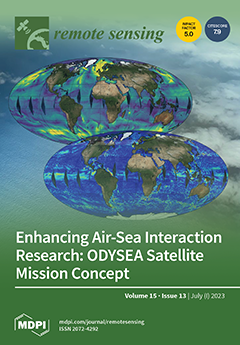Currently, climate change requires the quantification of carbon stored in forest biomass. Synthetic aperture radar (SAR) data offers a significant advantage over other remote detection measurement methods in providing structural and biomass-related information about ecosystems. This study aimed to develop non-parametric Random Forest regression models to assess the changes in the aboveground forest biomass (AGB), basal area (G), and tree density (N) of Mediterranean pine forests by integrating ALOS-PALSAR, Sentinel 1, and Landsat 8 data. Variables selected from the Random Forest models were related to NDVI and optical textural variables. For 2015, the biomass models with the highest performance integrated ALS-ALOS2-Sentinel 1-Landsat 8 data (R
2 = 0.59) by following the model using ALS data (R
2 = 0.56), and ALOS2-Sentinel 1-Landsat 8 (R
2 = 0.50). The validation set showed that R
2 values vary from 0.55 (ALOS2-Sentinel 1-Landsat 8) to 0.60 (ALS-ALOS2-Sentinel 1-Landsat 8 model) with RMSE below 20 Mg ha
−1. It is noteworthy that the individual Sentinel 1 (R
2 = 0.49). and Landsat 8 (R
2 = 0.47) models yielded equivalent results. For 2020, the AGB model ALOS2-Sentinel 1-Landsat 8 had a performance of R
2 = 0.55 (validation R
2 = 0.70) and a RMSE of 9.93 Mg ha
−1. For the 2015 forest structural variables, Random Forest models, including ALOS PAL-SAR 2-Sentinel 1 Landsat 8 explained between 30% and 55% of the total variance, and for the 2020 models, they explained between 25% and 55%. Maps of the forests’ structural variables were generated for 2015 and 2020 to assess the changes during this period using the ALOS PALSAR 2-Sentinel 1-Landsat 8 model. Aboveground biomass (AGB), diameter at breast height (dbh), and dominant height (Ho) maps were consistent throughout the entire study area. However, the Random Forest models underestimated higher biomass levels (>100 Mg ha
−1) and overestimated moderate biomass levels (30–45 Mg ha
−1). The AGB change map showed values ranging from gains of 43.3 Mg ha
−1 to losses of −68.8 Mg ha
−1 during the study period. The integration of open-access satellite optical and SAR data can significantly enhance AGB estimates to achieve consistent and long-term monitoring of forest carbon dynamics.
Full article





